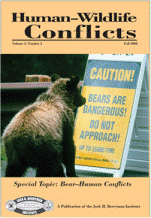Wildlife Damage Management, Internet Center for
Date of this Version
2007
Abstract
Beaver populations are healthy and well-established across North America aft er being nearly eliminated due to unregulated harvests during the previous 200 years. According to a 2004 survey of state wildlife agencies, a majority of states report beaver populations are stable or slightly increasing. However, the loss of trapping as a management tool can upset the current balance. For example, in Massachusetts, a beaver-trapping ban was passed through a public ballot referendum. With the inability to utilize effective quick-kill traps and live-restraining devices during regulated harvest seasons, beaver populations have increased significantly (Figure 1). Along with that increase in the population came an even greater number of complaints about beavers from homeowners, farmers, and communities, all of whom experienced varying degrees of economic loss.


Comments
Published in Human-Wildlife Conflicts Volume 1, Number 2, Pages 141-143, Fall 2007. Published and copyright by the Jack H. Berryman Institute. http://www.berrymaninstitute.org/journal/index.html